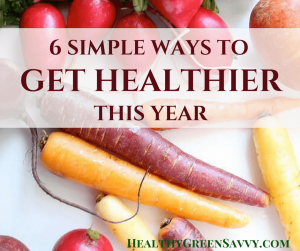Last Updated on January 3, 2025
Did you resolve to live healthier this year? Good going! Small can steps add up to big changes toward the healthy lifestyle you want.
Whether you’re just starting on a path toward healthy living or you’ve been at it awhile, knowing that small steps can add up to major change makes the journey easier. Don’t try to change everything at once, or you’ll likely get overwhelmed and give up.

Choose just one step to take to live healthier this year, whichever will be easiest for you to achieve. If you reach your goal before year’s end, feel free to pick another. Remember it takes time to develop new healthy living habits!
Ready to dive in? Below are some small healthy lifestyle changes with big impact to help you end the year healthier than you started.
1. Cut the Chemicals
Most of us are constantly assaulted with industrial chemicals. They’re in our water, the air, cleaning products, and personal care, from shampoo to deodorant.
It can be overwhelming when you decide to clean up your act! Start small and recognize getting harmful chemicals out of your life will be a slow process. Pick one area to work on at a time.
Cleaners are a great place to start because it’s so simple to replace conventional products with less toxic ones. Find more information on greener cleaning here.
–>To learn about more ways harmful compounds find their way into your house, pick up my free guide, “9 Steps to a Less Toxic Home” using the form here.
As I’m sure you know, there are also a number of potentially harmful chemicals in our food supply, from pesticides on produce to artificial flavors in processed food. Choose organic as much as possible, and read below about adopting a “real food” diet.
2. Ditch the Processed Food
Refined flours, sugar, and oils have had most of the nutrition stripped from them, and we’re learning more every day that what’s left behind may acquire some harmful properties during processing, like trans fats.
Many processed foods contain artificial flavors and colors, so if you eat them, you’ve just added a bunch of chemicals to your diet, many of which lack scientific data about effects on human health.
A whole foods diet is healthier for two reasons, then: 1) it provides your body with more of the nutrients it needs and 2) it protects you from the harmful compounds in processed foods.
Root out the fake food. Take a careful look at your pantry and refrigerator. If you’re not sure what’s processed, read the labels. Avoid products with ingredients that don’t sound like food, like red dye #4 and other chem-lab sounding words, like butylated hydoxyaisole.
Watch out for the words “flavoring” and “natural flavoring” as well. The word natural is completely unregulated and has no real meaning. Don’t be duped by claims that something is “all natural.”
For grain-based foods, you need to look for the word “whole” before wheat, or whichever grain, or what you’re getting has been stripped of the nutritious outer layers leaving mainly simple carbs. Better still if your grains have been soaked or sprouted to make their nutrients more bioavailable.
“Unbleached wheat flour” is a red flag — see how that word ‘whole’ is missing? You’ll find this as the first ingredient in a number of “multigrain” products, so don’t be fooled into thinking that label means it’s healthy.
–> Want to make the healthiest food more affordable? Find 14 proven strategies for saving big on healthy food in my e-book, Eating Healthy on a Budget. They can save you hundreds of dollars on groceries every year! Check it out here.
Get savvy about oils. Opinion has shifted about which forms of fat are healthiest. A few decades ago we were counseled to pick canola and ‘vegetable’ oil (and margarine!) over other types of fats. We’re learning now that these oils are perhaps more harmful than fats like coconut oil and butter.
Seed-based oils are heavily processed to extract the oil using chemicals like benzene, and they have upset the balance of omega-3 (the good fats in fish) to omega-6 fats (in canola and soybean oil) in the Western diet. Nutrition experts believe we should be getting these fats in a ratio of roughly 1:1, but most of us get 16x as much omega-6 than omega-3, a pattern linked to chronic inflammation and a number of preventable diseases. Also avoid anything hydrogenated and watch for transfats on labels.
3. Cut Back on Sugar
The standard American diet is absurdly high in sugar — an average of 22-30 teaspoons each day, up to five times what’s recommended! Our bodies are not designed to deal with these huge influxes of sugar, and studies have linked sugar consumption to obesity, heart disease, and diabetes.
Even if you don’t often indulge in desserts or drink sugary sodas, if you’re eating packaged cereal, crackers, sauces, snacks, soups, and salad dressings, you’re probably getting more sugar than you realize. If you also have a sweet tooth, you may be setting yourself up for long-term health problems. Getting savvy about sugar in your diet is a great move for better health.
You don’t have to deny yourself treats altogether. Check out these suggestions for healthier treats for numerous ways to enjoy treats without setting yourself up for preventable health conditions.
A key place to cut the sugar is where you don’t really want it anyhow. Sweet soup and crackers? No, thanks!
Become a label-reader and be on the lookout for all the different versions of sugar manufacturers have sneaked into our food. Sugars come in a number of forms, so here are a bunch more words to look out for if you want to avoid it:
- sugar
- high-fructose corn syrup
- corn sweetener or syrup,
- fruit juice concentrates — yes, they come from fruit, but in this form it’s just sugar!
- malt sugar
- anything ending in “ose” (like sucrose, fructose, dextrose, maltose, glucose, lactose)
- brown rice syrup
Honey, maple syrup, agave, and dates are also used to sweeten foods, and though they’re “natural” forms of sugar, they still need to be consumed in moderation. So just because a brownie recipe calls itself healthy or says “no refined sugar” doesn’t mean you can eat unlimited amounts.
Most health experts don’t recommend turning to artificial sweeteners (can you say processed food?), as they can wreak their own kind of havoc on your health, affecting your microbiome and contributing to other health conditions. Some experts speculate that the sweetness without the calories can actually lead us to crave more food.
If you’re looking for a sweetener that won’t raise your blood sugar, you can try whole leaf stevia in your tea or use one of the less processed versions of stevia in moderation. (Some nutritionists put stevia powder in the artificial sweetener category, and recommend avoiding it altogether.)
2024 update: If you’ve come across the book Glucose Revolution (or its author, biochemist Jessie Inchauspé, aka Glucose Goddess), you may have heard about the benefits of eating carb-rich foods after something with fiber and/or protein. If you’re trying to tame a sweet tooth, consider moving anything sweet or starchy to the end of your meals to help lessen swings in blood glucose. I’m working on an article on sequenced eating that I’ll link here when it’s live.
4. Eat More Fruits and Veggies

Ideally, that would be 5 to 9 servings every day, but only a tiny fraction of Americans get that much. It isn’t as hard as it sounds — snack on a carrot, add some spinach to your omelet. The tomato sauce on your pasta counts as well. Have a vegetable soup as part of your meal and you’re well on your way.
Even if you’re eating mainly whole foods, if you’re not getting in enough fruits and veggies, you’re missing out on key nutrients and antioxidants that support immune function, protect heart health, help you sleep better, and give you energy.
It’s best to “eat the rainbow” — lots of different color fruits and veggies — to get the widest range of nutrients and antioxidants.
Try some of these completely delicious ways to get veggies not only in your meals, but your desserts!
♦ 25 Kale Recipes that Will Make You Crave Kale
Growing your own fresh veggies is a great way to get the freshest local produce for very little money! Here’s a beginner’s guide to gardening, and here’s how to grow vegetables indoors any time of year.
Bonus: Gardening will help you move more (see tip #5) and contact with nature reduces stress (#6)! Win-win-win!
5. Move More, Sit less
Even if you’re not really into exercise, sitting less is a savvy move and will improve your health. (Read this post to find out more.) Moving more can also happen with baby steps. If you currently don’t exercise at all, walking 5 minutes a few times a week is a great start. Something is far better than nothing!
Or find an activity you enjoy that lets you get some exercise without noticing. A dance class, gardening, or a martial art can all give you a workout.
Even if you don’t have much time, sneak in a little activity each day and your body will thank you. This could mean walking or biking rather than driving, taking the stairs instead of the elevator, or squeezing in just 10 minutes jumping around with kids or moving to music.
My DIY treadmill desk has made getting more movement in every day SO much easier. It’s inexpensive, requires very little assembly (and no skills), and means no more long hours of sitting while I work. So much less shoulder, neck, and back pain at the end of the day!
6. Manage Stress
Stress is not only unpleasant, it’s really tough on your body. Stress has been linked to a number of health conditions, including depression, cardiovascular disease, diabetes, and decreased immunity. Some simple stress-management techniques can help, and some are as easy as having a good laugh or listening to music. (Good news: Taking some of the steps above will likely help in your stress-management efforts.)
Need some other Savvy Health Hacks? Check out these easy ways to ensure your body has what it needs to function optimally:
- Are You Getting Enough Magnesium?
- Why You Need a Water Filter
- Health Benefits of Potassium
- Health Benefits of Turmeric
- Are You D-ficient?
Pin to save these tips to live healthier for later!

Disclaimer: I’m a health enthusiast, not a medical professional. Content on this website is intended for informational purposes only and is not meant to provide personalized medical advice. Please consult a licensed professional for personalized recommendations.
Live healthier photo credits: Le living and co, Simon Thomas, Moyan Brenn, Honolulu Media, Juhan Sonin, Alan Cleaver, Joseph

Susannah is a proud garden geek and energy nerd who loves healthy food and natural remedies. Her work has appeared in Mother Earth Living, Ensia, Northern Gardener, Sierra, and on numerous websites. Her first book, Everything Elderberry, released in September 2020 and has been a #1 new release in holistic medicine, naturopathy, herb gardening, and other categories. Find out more and grab your copy here.


 Hi, I'm Susannah, a garden geek, energy nerd, and fan of healthy food and natural remedies. Need some simple, practical solutions for living healthier and greener? You've come to the right place! More about me and my green projects
Hi, I'm Susannah, a garden geek, energy nerd, and fan of healthy food and natural remedies. Need some simple, practical solutions for living healthier and greener? You've come to the right place! More about me and my green projects